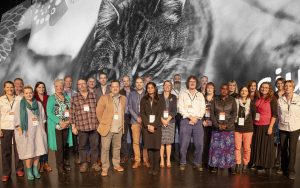The Peel-Harvey Catchment Council applauds the State Government decision to list feral cats as a declared pest under the Biosecurity and Agricultural Management Act 2007.

“The collective efforts to protect Western Australia’s biodiversity has just had a significant boost”, said PHCC Chairman, Caroline Knight.
“We are absolutely thrilled that the Minister has taken this step, and particularly that the listing is across all land tenures, not just areas managed by the State, as happened in Victoria in 2018.” She said
Minister MacTiernan has made the right decision. Our community has long recognised the devastation feral cats do to our native animals, and the community want to be part of the solution, particularly where their properties abut or are near significant reserves and parks that are refuge for native animals.
Now that Feral Cats are listed, community can work more closely with government, industry and researchers towards landscape scale solutions in the most humane and cost effective manners.
Our intention is to support a collaborative effort through the WA Feral Cat Working Group. The Working Group was identified as a priority action at the expert panel workshop that followed the 2018 WA Feral Cat Symposium, run by the Peel-Harvey Catchment Council. The Symposium was a huge success with nearly 200 people from across Australia coming together to tackle the complex issue of protecting WA’s native animals, through effective, humane feral cat control.
On the day after the Symposium a smaller group of key stakeholders gathered to discuss the way forward. It was unanimously agreed that the establishment of a WA Feral Cat Working Group was a priority so that representatives of all relevant sectors can continue to support each other by sharing information, resources, and actions to remove the barriers to effective coordinated landscape-scale control of feral cats across WA. At this stage a small number of nominated representatives from the Peel-Harvey Catchment Council, WA Biodiversity Science Institute, Bush Heritage and the Department of Biodiversity Conservation and Attractions, have kept things moving, waiting for the listing. The Working Group already has the endorsement of the Threatened Species Commissioner, Sally Box as well as the National Feral Cat Taskforce and the State Biosecurity Council.
Ms Knight reiterated “We do need to be very clear that this is about feral cats, not domestic or stray cats, they are covered under the Cat Act, 2011 and that is a different conversation. This is about feral cats and the collaborative efforts of community to reduce the catastrophic impacts to our native animals.
Predation by feral cats have contributed to the extinction of 22 Australian mammal species and are a threat to 75 critically endangered and near threatened mammal species 40 birds, 21 reptiles and 4 amphibians. There are approximately 2.07 million feral cats in natural environments across Australia. Each year these cats consume 316 million birds, 596 million reptiles and 900 million mammals, on average. Translated into impact in Western Australia, this represents around 720,000 feral cats consuming 570 million birds, reptiles and mammals across the state, each year. Additionally, the feral cat is host to a number of disease-causing bacteria and viruses, with more than 100 pathogens recognised, 30 of which are also recorded in native mammal species. Taken together, there is no single greater threat to Australia’s mammals in particular, and terrestrial biodiversity in Australia more generally, than the feral cat.
“We look forward to a future where our native animals can come out from behind protective fences and once again be a part of our landscape and thank the WA Government for taking this step” Ms Knight said.
ENDS
Media Contact: Jane O’Malley, Chief Executive Officer, Peel-Harvey Catchment Council, [email protected], (08) 6369 8800



